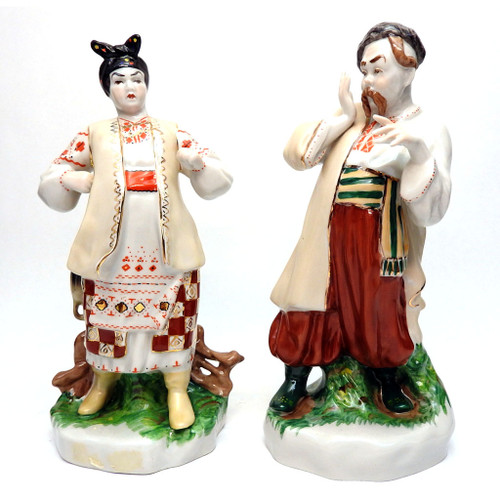Product Description
Solokha with mortar & pestle grinder (Солоха со ступой). Kiev Experimental Ceramic-Art Factory (KEKhZ). The statuette is based on an original design by the master sculptor Vladislav Ivanovich Shcherbina (1926–2017). Kiev Factory red book backstamp used from 1960-1975. English letters indicate piece was made for export. Porcelain, overglaze art painting, gilding, glaze. Excellent condition, no restoration, no damage. Uncommon. 9" in height, 1 only.
Solokha is a literary character from Nikolai Gogol's book "Evenings on a Farm Near Dykanka" ("Вечера на хуторе близ Диканьки"), which is a group of short stories by Nikolai Gogol (1809-1852), written in 1829–1832. They appeared in various magazines and were published in book form when Gogol was twenty-two. Dykanka is a settlement in central Ukraine.
Gogol was born in Velyki Sorochyntsi (Великие Сорочинцы) near Poltava, and spent his early life in Ukraine. Later, he put his early impressions and memories of childhood into these stories of peasant life. He used letters to his mother as primary sources for the descriptions of village customs, dress, and superstitions. The name Solokha is apparently derived from Solomonia (Соломония, or Соломия), the feminine form of Solomon.
The Kiev Experimental Art Ceramics Factory (Kiev ECC) was founded in 1924 on the basis of a small workshop, which manufactured ceramic paints and decals. During World War II, the plant was destroyed but restored with the influx of capital investment. Mid-20th century found an expansion of the factory to manufacture decorative articles. Eventually the large art workshop became one of the best in the USSR at that time. Famous porcelain artists and sculptors that worked at the plant included O. L. Zhnikrup , V. I. Shcherbina , O. P. Rapay-Markish , G. M. Kaluga, A. D. Sorokin and many others. Also, Petrikov's painting on porcelain was introduced here for the first time. The fall of the USSR was not kind to these types of enterprises and eventually the factory ceased to exist. A collection of museum-quality pieces were to have been transferred to the State Museum of Decorative Ukrainian Art, but instead disappeared and presumed stolen. The factory's last incarnation was as Kiev Porcelain LLC, and went under in 2006.











